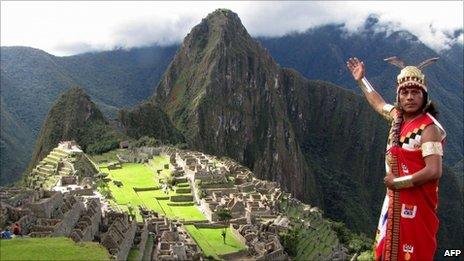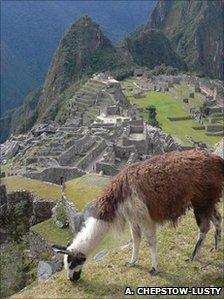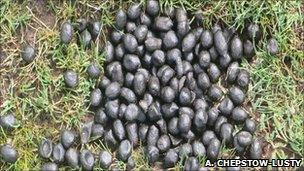Inca success in Peruvian Andes 'thanks to llama dung'
- Published

The 'lost city' of Machu Picchu is now Peru's main tourist attraction
One of the world's greatest ancient civilisations may have been built on llama droppings, a new study has found.
Machu Picchu, the famous Inca city set in the Peruvian Andes, celebrates the centenary of its "'discovery" by the outside world this July.
Dignitaries will descend on site for a glitzy event in July marking 100 years since US explorer Hiram Bingham came upon the site, but the origins of Machu Picchu were far less glamorous.
According to a study published in archaeological review Antiquity, llama droppings provided the basis for the growth of Inca society.

Llamas have left their mark - literally - on history
It was the switch from hunter-gathering to agriculture 2,700 years ago that first led the Incas to settle and flourish in the Cuzco area where Machu Picchu sits, according to the study's author Alex Chepstow-Lusty.
Mr Chepstow-Lusty, of the French Institute of Andean Studies in Lima, said the development of agriculture and the growing of maize crops is key to the growth of societies.
"Cereals make civilisations," he said.
Mr Chepstow-Lusty has spent years analysing organic deposits in the mud of a small lake, "more of a pond really," called Marcaccocha on the road between the lower-lying jungle and Machu Picchu.
His team found a correlation between the first appearance of maize pollen around 700BC - which showed for the first time that the cereal could be grown at high altitudes - and a spike in the number of mites who feed on animal excrement.
They concluded that the widespread shift to agriculture was only possible with an extra ingredient: organic fertilisers on a vast scale.
In other words, lots of llama droppings.
Llamas' legacy
Llamas were and still are commonly used in the Peruvian Andes to carry goods and provide meat and wool.
Marcaccocha is situated next to an ancient trade route, and llamas transporting goods between the jungle and the mountains would stop to have a drink and "defecate communally".
"This provided fertiliser which was easily collectable as today by the local people for the surrounding field systems," Mr Chepstow-Lusty said.

Llama droppings are still used for crop fertiliser and cooking fuel
As the Incas moved from eating wild quinoa to maize, which is higher in calories, their society developed in the Cuzco area.
Some 1,800 years after they first moved from hunter-gathering to agriculture, around 1100AD, a bout of prolonged warmer weather allowed the civilisation to really flourish, leading to the building of large stone settlements like Ollaytaytambo and Machu Picchu.
Today, the Incas are long gone, largely wiped out by the Spanish conquistadors in the 1500s. But their descendants, the Quechua, still use llama droppings for fertiliser and cooking fuel.
"The valley is full of indigenous people who follow that way of life from 2,000 years ago," said Mr Chepstow-Lusty.
When the guests arrive in Machu Picchu to celebrate 100 years since Hiram Bingham brought it to the world's notice, they can perhaps thank the humble llama for the sight they see before them.
Related topics
- Published31 March 2011
- Published26 August 2010